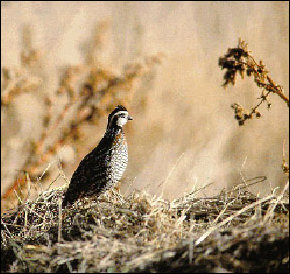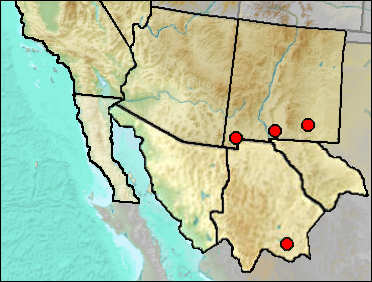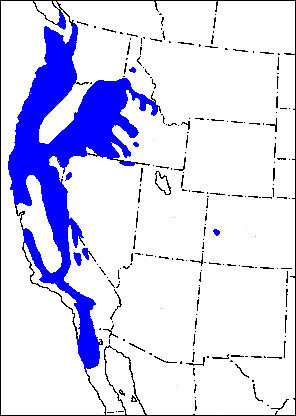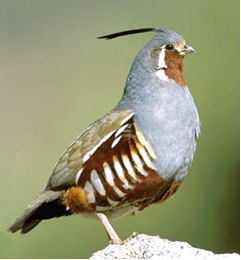Class Aves
Order Galliformes
Family Odontophoridae
Callipepla sp.—Crested Quail // Callipepla gambelii—Gambel's Quail // Callipepla squamata—Scaled Quail // Colinus virginianus—Northern Bobwhite // Cyrtonyx montezumae—Montezuma Quail // Oreortyx pictus—Mountain Quail

Howard (1971:238) identified "Quail, 2 species?" from Dark Canyon Cave with no further comment.
Sites.
Mid/Late Wisconsin: Dark Canyon Cave (Howard 1971).
Literature. Howard 1971.

Synonyms—Lophortyx (part).
Birds currently recognized as members of the genus Callipepla include those formerly placed in Lophortyx and Colinus. The two species of Callipepla in our region are of similar size and difficult to discriminate on osteological grounds.
Sites.
Early/Early-Mid Wisconsin: Sabertooth Camel Maze (Harris 1993; cf.).
Mid/Late Wisconsin/Holocene: Sierra Diablo Cave (UTEP); Shelter Cave (Howard and Miller 1933).
Late Wisconsin: Camel Room (Harris 1993c: cf.); Pendejo Cave (Harris 2003); Stalag 17 (Harris 1993c: cf.).
Late Wisconsin/Holocene: Conkling Cavern (Howard and Miller 1933); Pendejo Cave (Harris 2003).
Literature. Harris 1993c, 2003; Howard and Miller 1933.

Synonyms. Lophortyx gambelii.
 Gambel's Quail
generally stick closer to valley habitats than does the Scaled Quail in our area;
however, sympatric occurrences under present conditions are not rare. The present
distribution centers from California to central New Mexico and south into Mexico, but
isolated populations occur in the Great Basin and Colorado (Johnsgard 1973).
Gambel's Quail
generally stick closer to valley habitats than does the Scaled Quail in our area;
however, sympatric occurrences under present conditions are not rare. The present
distribution centers from California to central New Mexico and south into Mexico, but
isolated populations occur in the Great Basin and Colorado (Johnsgard 1973).
Fig. 1. Gambel's Quail. Photograph by John J. Mosesso, National Biological Information Infrastructure.
Sites.
Late Wisconsin/Holocene: Conkling Cavern (Harris 1993c: ?); Deadman Cave (Mead et al. 1984).
Literature. Harris 1993c; Johnsgard 1973; Mead et al. 1984.

Scaled Quail tend to be birds of the Upper and Lower Sonoran Life Zones, widespread from desert grassland into open piñon-juniper woodlands. Generally open woody vegetation is required (mesquite or juniper savannah, for example) (Johnsgard 1973).
Rea (1973) reviewed modern distribution, archaeological records, and fossil occurrences of this species.
Sites.
Mid Wisconsin: Pendejo Cave (Harris 2003: cf.).
Mid Wisconsin-Holocene: Shelter Cave (Rea 1973).
Mid/Late Wisconsin: Dark Canyon Cave (Rea 1973);
Late Wisconsin: Sandia Cave (Brasso and Emslie 2006: cf.).
Literature. Brasso and Emslie 2006; Harris 2003; Johnsgard 1973; Rea 1973.

 Fig.
1. Colinus virginianus. US Fish & Wildlife Service photograph.
Fig.
1. Colinus virginianus. US Fish & Wildlife Service photograph.
This quail now occurs in eastern New Mexico, eastern Sonora, and, historically, in southeastern Arizona. Ligon (1961) considered it likely that it occurred in recent time in the Animas Valley of the bootheel of New Mexico. In eastern New Mexico, it is associated with low, shrubby growth (Johnsgard 1973).
The U-Bar Cave quail fits the general characters of this species but is not identified with certainty; Mid-Wisconsin occurrence would be reasonable considering the current distribution in the nearby Animas Valley.
Sites.
Mid Wisconsin: U-Bar Cave (Harris 1993c: ? gen. et sp.).
Late Wisconsin: Skull Cave (Emslie 1988: cf. gen. et sp.).
Literature. Emslie 1988; Harris 1993c; Johnsgard 1973; Ligon 1961.

Montezuma Quail currently occurs in the highlands of central and southern Arizona and New Mexico south into the Big Bend and Mexico. Ligon (1961) noted the altitudinal range as from 5,000 to 12,000 feet and the preferred habitat as containing rank grasses.
Sites.
Early/Early-Mid Wisconsin: Rm Vanishing Floor (Harris 1993c: cf. gen. et sp.).
Mid Wisconsin: Papago Springs Cave (Czaplewski and Mead et al. 1999 cf. gen. et sp.).
Late Wisconsin/Holocene: Deadman Cave (Mead et al. 1984).
Literature. Czaplewski and Mead et al. 1999; Harris 1993c; Mead et al. 1984.

 This relatively large
quail is, according to Johnsgard (1973:345), "perhaps the most temperate-adapted
of any species,..." It breeds from sage and piñon-juniper habitat into higher
elevation dense brush and in coniferous forest.
This relatively large
quail is, according to Johnsgard (1973:345), "perhaps the most temperate-adapted
of any species,..." It breeds from sage and piñon-juniper habitat into higher
elevation dense brush and in coniferous forest.
Fig. 1. Map of current distribution of Oreortyx pictus, including modern introductions (Colorado, Vancouver Island, Washington). Map adapted from Johnsgard 1973.
The current distribution of Mountain Quail is shown in Fig. 1. Its occurrence in southern New Mexico during the Wisconsin depicts a major change in geographic range (Messing [1986] also reported it tentatively from Jimenez Cave in southern Chihuahua). However, successful modern introduction into Colorado into an environment not too different from that hypothesized for the late Pleistocene in our area suggests that occurrence in our region is not as unlikely as it might seem on its face.
 Howard
(1962) tentatively assigned three quail bones to this species, but noted that they are
somewhat smaller than the comparative material at hand.
Howard
(1962) tentatively assigned three quail bones to this species, but noted that they are
somewhat smaller than the comparative material at hand.
Fig. 2. Mountain Quail. Photograph courtesy of the U.S. Fish and Wildlife Service.
Sites.
Mid/Late Wisconsin: Shelter Cave (Howard and Miller 1933).
Late Wisconsin: Burnet Cave (Wetmore 1932); Howell's Ridge Cave (Howard 1962: cf. gen. et sp.).
Literature. Howard
1962; Howard and Miller
1933; Johnsgard 1973;
Messing 1986; Wetmore 1932.
Last Update: 18 Mar 2013